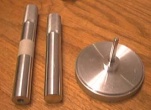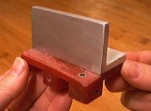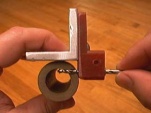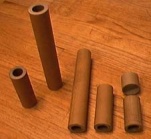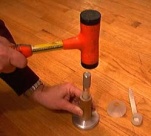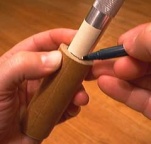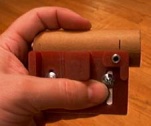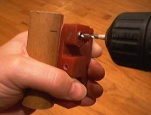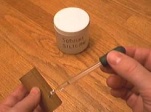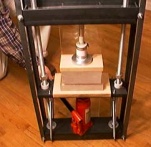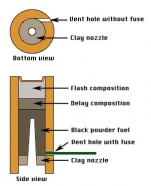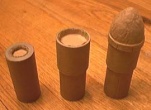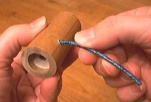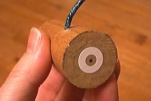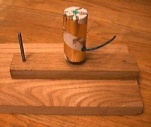Stinger missile
From PyroGuide
The name stinger missile seems to have become fairly common among pyro hobbyists to refer to the class of rockets which are spin stabilized. This means that the usual efforts to assure a predictable flight path of a rocket, which include body fins or a guide stick, can all be dispensed with. Consequently, the spin stabilized rocket is extremely easy to make. This is what makes them so much fun. Unlike a girandola project, these little jewels can be made in a few minutes and launched immediately. It's a great fix for the smoke addicted pyro who often needs to throw something together quickly. The methods presented here closely follow those first described by Warren Klofkorn some 10 years ago. His article appears in "The Best of AFN II" on page 62 and has become the standard reference for stinger missile construction. A description of my personal experience with his instructions and a few other innovations, hints and tips are included here in the hope that they might make your experience more enjoyable.
[edit] MaterialsTools | ||||||||||
|
This is a close-up of the jig used to position the side vent hole in the stinger body tube. This hole is used to create tangential thrust which will cause the rocket to spin as it flies. The angular momentum of the spinning rocket is what stabilizes it instead of relying upon positioning the center of pressure behind the center of gravity, as accomplished by fins or sticks. This jig helps to accurately position the vent hole to consistently achieve a good spin. The desired location of this vent hole is just above the clay nozzle and in a direction that is at a tangent to the inside surface of the tube. This jig may look a little different from the present Skylighter product, but the function is identical. | ||||||||||
[edit] ConstructionTo adjust the jig for the size of stinger you plan to make, you must first loosen the two screws until they allow the guide hole plate to slide relative to the angle piece. First adjust the screws to be slightly snug so that the two jig pieces aren't overly floppy, but will slide with a little effort. | ||||||||||
|
Now get a piece of stinger tubing and hold it against the jig as shown. Place the 9/64 drill bit (provided with the stinger tool kit) in the guide hole and check the alignment as illustrated in the picture. The drill bit should be positioned so that its side flutes are even with the inside wall of the tube. If this verbal description is not clear, just look at the picture. As they say, it's worth a thousand words. Now, if your alignment isn't correct, just slide the jig pieces until it is, and then tighten the screws. This alignment will assure that, when drilling the side vent hole, the drill bit will emerge at the right place on the inside surface of the tube. With the vent hole aligned correctly, you will achieve the best thrust angle to maximize spin and stability. Be sure that your adjustment screws are in the same places in the two slots, assuring that the two jig pieces are parallel to each other. Another good tip to use at this point is to put a small piece of tape on the drill bit to mark the proper depth of insertion into the guide hole. The proper depth is also shown in the picture. If the drill bit is allowed to go any further into the guide hole, it will begin to drill into the opposite wall of the tube, causing undesirable weakening at that point. With this done, the jig set up is complete and you're ready to get your hands dirty and have some real pyro fun. | ||||||||||
|
Construction of the stinger starts by preparing the body tube. A typical 1 pound rocket tube may be used. The Skylighter TU1068 is a good example. It measures 3/4 inch ID, 1-1/4 inch OD and 7-1/2 inches long. You can save money if you buy the longer TU1065 from which you can cut as many as 9 stinger tubes. Either way, a tube must be cut to a length that depends on what heading is planned for the payload of the rocket. Cutting these heavy tubes is best accomplished by using a table or radial arm saw because a clean, square end is desirable. A length of 3 inches is typical for a rocket which contains some colored star composition for delay and some flash powder for a salute finish. Another option is to add a header extension filled with stars and some burst composition. When this option is chosen, the body tube can be cut a little shorter, enabling three stingers to be made from a single 1 pound rocket tube. The construction of these headers will be covered later. | ||||||||||
|
With the tube cut to the desired length, it is placed over the spindle on the spindle base and a carefully measured amount of nozzle clay is poured into the tube. A small funnel of some sort, as shown on the floor in the picture, is very helpful in accomplishing this. Klofkorn's original article advocated the use of 4.3 cc of powdered Hawthorne Bond clay for the rocket nozzle. I use a 60%/40% mix of bentonite and kyanite treated with an additional 5% of toilet seal wax dissolved in Coleman fuel. Instead of using a volume measurement for the nozzle clay, I recommend that you use a weight measurement so that a consistent nozzle length is achieved. The importance of doing this will become evident shortly. Stay tuned. If you are not using a hydraulic press, the nozzle clay is compacted by administering about a dozen firm blows (this is called "ramming") with a mallet of some sort, as shown in this picture. Although a little bulge in the tube wall can be desirable after ramming or pressing, be careful not to split the tube. | ||||||||||
|
Before drilling the side vent hole in the body tube, a mark must be made on the outside of the tube to indicate where the top of the nozzle is located. Start by applying a piece of masking tape to the rammer so a mark can be easily made on it. Then place the rammer in the body tube until it seats against the nozzle. Now make a mark on the masking tape, as shown. Of course, if you were really on the ball, you could do this right after you finished ramming the nozzle clay, in the step above. | ||||||||||
|
Next, remove the rammer and hold it against the outside of the tube with the mark you just made even with the top of the tube. Make a mark on the body tube at the bottom of the rammer. This mark should now indicate where the top of the nozzle is inside the tube. | ||||||||||
|
Now the tube is held in the drilling jig, as shown. The guide hole should be located so that the side vent hole will be drilled just above the nozzle. In case you haven't figured it out, you should remove the tube from the spindle base before you drill the side vent hole. | ||||||||||
|
Hold the tube in the drilling jig in one hand, properly positioned as shown in this picture. Then the hole is slowly drilled with a hand drill, taking care to firmly grip the tube in the jig so that it doesn't move. Again, note the piece of tape on the drill bit, which indicates the proper depth for the drill bit in the guide hole. Now pay close attention. Here comes the nifty tip you've been waiting for. Once the location of the top of the nozzle has been established, it should be measured and preserved in your notebook. This measurement can be used in all future stingers with the assumption that it will always be accurate. The assumption is a safe one to make if your nozzles are always made the same way with exactly the same compression and same amount of clay. The significance is that the side vent hole can be drilled before the nozzle is rammed, eliminating the need to remove the tube from the spindle to locate the top of the nozzle and drill the hole after nozzle ramming. It's a nice little time savings. | ||||||||||
|
The vent hole can be made more impervious to hot exhaust gasses by treating it with a few drops of sodium silicate solution, as shown in this picture. An eye dropper is used to put the silicate into the hole. A toothpick or small nail is then used to spread it around in the hole and prevent blockage or constriction of the hole. Some of my impatient pyro friends skip this step to avoid waiting for the required 20 minutes for the silicate to dry in the vent hole. Their stingers still seem to fly just fine, albeit possibly not quite as high. | ||||||||||
|
This picture illustrates the use of a typical rocket press to form the nozzle and load the black powder fuel. When a hydraulic press is used instead of a mallet, a reinforcing sleeve is a good idea to avoid deforming the rocket tube. Which ever method is used to load the black powder fuel, a little scoop, as shown in the hand ramming picture above, is handy for measuring out the fuel for each pressed increment. I made mine by hot gluing the bottom section of a film canister to a small garden marker stick. The black powder fuel must be compacted in the tube in about 4 or 5 increments, each of which should be no longer than the inside diameter of your stinger tube. For the black powder fuel, I use the same milled meal that I use to make a good lift powder. It contains willow charcoal to make a very hot rocket fuel. This fuel would be too hot for a standard 1 pound rocket, but for stingers it works very well because the rocket core is considerably shorter. I have notice, however, that in the case of the larger 3 pound stingers, my home-made black powder is a little too hot. I experienced a few explosions immediately upon ignition until I cooled the fuel down a little with a few percent of mineral oil. As with most black powder based rockets, you may need to experiment a little to dial in the proper burn rate for your stingers. | ||||||||||
|
After the rocket has been charged with its black powder propellant, some delay composition should be loaded above it to allow the stinger to reach its apogee. Otherwise, your stingers will activate their payloads at very low altitudes because the actual thrust burn only lasts about 1 second. The following green star composition is suggested by Klofkorn as a safe and compatible delay element:
Somewhere between 6 cc and 9 cc of this composition, damped with a sparing amount of alcohol, is pressed into the top of the tube using moderate pressure only. It is a good idea to give this delay composition a little drying time before adding the final heading to the rocket. The diagram at the left shows the internal structure of the missiles after a heading of flash powder has been added. There is nothing sacred about this particular way of making a delay. Dextrin can be substituted for the rice starch or a totally different delay composition can be used. I am a little partial to some of the glitter formulas, myself, such as Winokur #39. | ||||||||||
|
Now we are ready to talk about the various heading options for our stingers. After all, what's the point of making a rocket that just spins as it flies if it doesn't do something cool at the end of its flight? The easiest heading is 3 cc of flash powder in the remaining cavity of the stinger tube. This is finished by gluing (white or Elmer's glue) a 3/4 inch end plug that just touches the flash powder enough to keep it from shifting during the spinning ascent. An easy shell header with stars an be constructed using a 1-1/2 inch length of paper tube whose inside dimension is 1-1/4 inches. This tube is glued to the stinger tube with a 1/2 inch overlap. The expanded cavity now has more room to accommodate a larger payload of stars and burst. The payload space needs to be filled completely and firmly packed so that no asymmetries can be created when the stinger spins. The cavity can be closed in a variety of ways. A typical end plug or cap will do the trick, but if you want to maximize your payload space, a molded nose cone can be used. The nose cone shown in the picture is molded from craft paper pulp bound with CMC binder. An example of each of these header options is shown in the picture. Again, whatever header is chosen, care must be taken to avoid asymmetries, or your stingers will wobble all over the sky. | ||||||||||
|
Now a fuse is added to the side vent hole. A 1/8 inch drill bit (1/64th smaller than the one used to drill the hole in the tube to start with) is inserted into the hole and twisted gently by hand to open a small cavity in the black powder fuel grain. A glob of Meal D wetted with nitrocellulose lacquer is placed on the end of a 3-inch length of visco fuse. The globbed end is inserted into the vent hole as far as it will go. The lacquer will dry shortly and secure the fuse in place. I don't bother to bend it against the tube wall and affix it with tape, as recommended by Klofkorn. This practice has damaged the somewhat brittle visco and has caused failure of ignition on some of my stingers. If you use a more flexible fuse, this may still be a good idea to make the fuse more secure during storage and transport. | ||||||||||
|
A little bit of added stability at lift off can be achieved by gluing a custom reinforcement to the business end of the stinger. This is accomplished by tracing a circle around a stinger tube on a piece of strong tissue paper. A notebook paper hole reinforcement is then glued to the center of the circle. The circle is cut out and glued to the nozzle end of the stinger as shown in the picture. The launch spindle will be inserted through the hole of the reinforcement at launch time. The reinforcement helps the stinger spin about its central axis without wobbling. Another possibility I have seen used for this purpose is a standard paper end plug with a hole punched in it. The end plug is not glued into place so it will easily be blown out when the stinger flies. These end plugs may usually be re-used a few times before they become too badly charred. | ||||||||||
|
The stinger missile requires a custom launch pin to support it prior to launch and during initial spin-up of the device. This can be as simple as a nail driven through a good sized piece of wood to give it a solid footing during launch. The last thing you want when these things start spinning is for the launch stand to tip over and send an angry stinger missile into your terrified audience. The nail is rounded at the end by a file to provide a good pivot point at the top of your stinger core. This picture shows a typical launch stand with two launch pins, one supporting a finished missile ready for launch. A little decorative paper has been added to give it a festive flair. All that remains is to light the fuse, retire to a safe distance and feel the rush these marvelous little rockets give to their creator and his audience. |
[edit] Video
Stinger missile - 1.7meg - A example stinger missile with no payload.
[edit] References
- Dan Williams, Amateur Pyrotechnician - http://fogoforum.us/index.html
- Warren Klofkorn - PyroTooling
